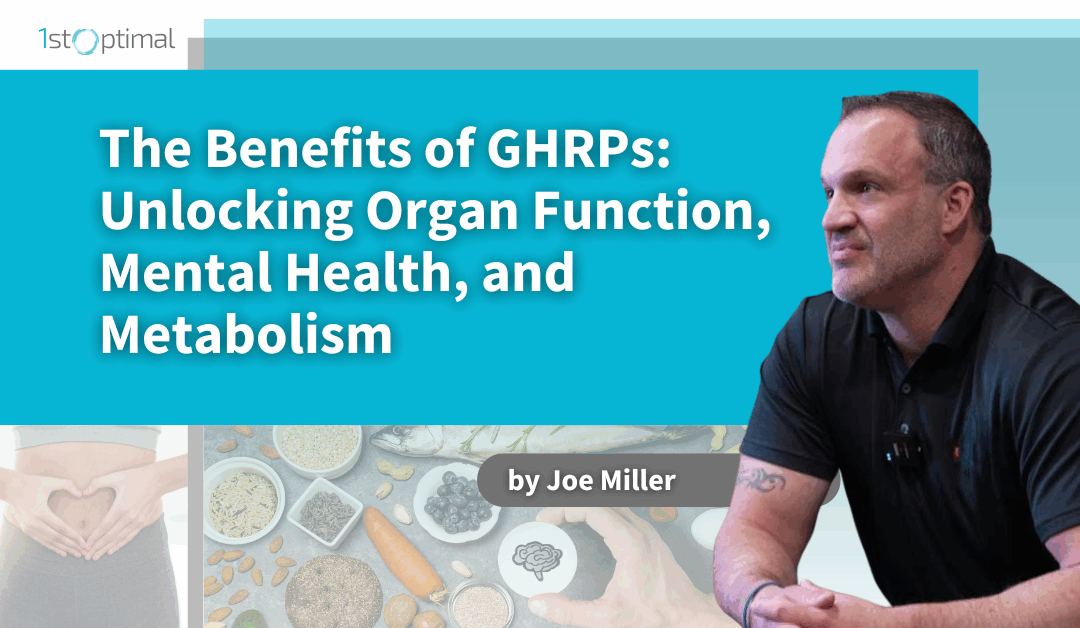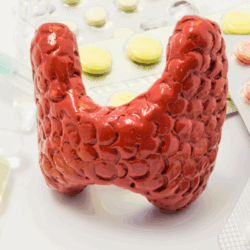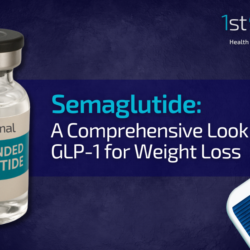Introduction
Growth hormone-releasing peptides (GHRPs) are an exciting breakthrough in functional medicine, hormone therapy, and performance health. Semorelin and Tesamorelin, two FDA-approved GHRPs, are gaining popularity for their ability to boost growth hormone levels naturally. These peptides support a range of health benefits that extend beyond increasing muscle mass, they are known for their positive effects on organ function, mental health, and metabolic health.
As more people seek personalized health optimization solutions, peptides like Semorelin and Tesamorelin offer a safe, effective way to address hormone deficiencies and promote long-term wellness. In this article, we explore the profound benefits these peptides offer and how they can be integrated into a comprehensive wellness program.
Table of Contents
- What Are GHRPs?
- Semorelin vs. Tesamorelin: Key Differences
- The Impact of GHRPs on Organ Function
- GHRPs and Mental Health: Enhancing Cognitive Function
- Boosting Metabolism and Weight Management with GHRPs
- How GHRPs Support Longevity and Overall Health
- FAQs about GHRPs, Semorelin, and Tesamorelin
- Conclusion: Optimize Your Health with GHRPs
What Are GHRPs?
Growth hormone-releasing peptides (GHRPs) are synthetic compounds that stimulate the pituitary gland to release more growth hormone (GH). Growth hormone plays a critical role in muscle growth, fat metabolism, tissue regeneration, and overall health.
By increasing GH production, GHRPs like Semorelin and Tesamorelin offer a variety of benefits, from improving physical performance to enhancing mental health. These peptides function by mimicking growth hormone-releasing hormone (GHRH), which naturally signals the release of GH from the pituitary gland.
Semorelin vs. Tesamorelin: Key Differences
- Semorelin: Primarily used to stimulate GH production in patients suffering from growth hormone deficiency. It has broader applications in general health optimization and aging.
- Tesamorelin: Used specifically to address HIV-associated lipodystrophy, Tesamorelin focuses on reducing visceral fat (fat around internal organs) and improving fat metabolism. It has been found to be highly effective for improving body composition in non-HIV patients as well.
Both peptides have a similar mechanism of action but are applied differently in clinical settings, depending on the individual’s needs.
The Impact of GHRPs on Organ Function
As we age, our growth hormone levels naturally decline, which can affect the functioning of key organs. By boosting GH production, Semorelin and Tesamorelin can play a crucial role in maintaining and improving organ health.
How GHRPs Improve Organ Health:
- Heart Health: Adequate growth hormone is essential for maintaining cardiovascular function. Studies show that GH can improve vascular health, leading to better blood circulation and a reduced risk of heart disease.
- Liver Function: Growth hormone stimulates the regeneration of liver cells, enhancing the organ’s ability to detoxify and metabolize nutrients.
- Kidney Health: GH is critical for renal function, aiding in the regeneration of kidney cells and maintaining proper filtration.
- Skin & Tissue Regeneration: Growth hormone encourages the production of collagen, helping maintain skin elasticity and promote faster wound healing.
GHRPs and Mental Health: Enhancing Cognitive Function
Growth hormone not only supports physical health but is also linked to mental well-being. Research has shown that Semorelin and Tesamorelin have a significant impact on cognitive function, mood regulation, and overall brain health.
- Cognitive Function: GH is associated with memory improvement, focus, and mental clarity. Adequate levels of GH support neurogenesis (the formation of new neurons), helping prevent age-related cognitive decline.
- Mood Enhancement: Low GH levels have been linked to depression and anxiety. By stimulating GH release, these peptides can help elevate mood and reduce stress.
- Neurogenesis: As we age, the brain’s ability to regenerate neurons declines. GH can reverse this process, enhancing learning and memory capabilities.
Boosting Metabolism and Weight Management with GHRPs
GHRPs like Semorelin and Tesamorelin are highly effective in boosting metabolism and aiding in weight management. As we age, our metabolism slows down, which often leads to weight gain and fat accumulation.
How GHRPs Help with Weight Management:
- Fat Loss: GHRPs stimulate the breakdown of visceral fat—the type of fat stored around internal organs—which is essential for maintaining a healthy body composition.
- Muscle Mass: GH encourages the growth of lean muscle mass, which in turn helps increase the body’s caloric burn at rest.
- Improved Insulin Sensitivity: Semorelin and Tesamorelin improve the body’s ability to utilize insulin, reducing the likelihood of fat storage and supporting stable blood sugar levels.
This makes GHRPs a powerful tool for anyone looking to optimize body composition and enhance fat metabolism.
How GHRPs Support Longevity and Overall Health
Maintaining optimal growth hormone levels is one of the keys to a longer, healthier life. Research shows that GH therapy can improve lifespan and quality of life by promoting cell regeneration, enhancing immune function, and supporting bone health.
Longevity Benefits of GHRPs:
- Cell Regeneration: GHRPs stimulate the regeneration of damaged cells, which helps slow down the aging process and supports a youthful appearance and vitality.
- Immune Function: Studies suggest that GH has a role in boosting the immune system, helping the body fight infections and illnesses.
- Bone Health: GH is critical for bone density, reducing the risk of conditions like osteoporosis and ensuring strong bones as we age.
Incorporating Semorelin and Tesamorelin into a health optimization routine can help slow the aging process and extend overall well-being.
FAQs about GHRPs, Semorelin, and Tesamorelin
1. What is the difference between Semorelin and Tesamorelin?
Semorelin is used to stimulate growth hormone production for general health optimization, while Tesamorelin is specifically aimed at reducing visceral fat in HIV-associated lipodystrophy but also works well for improving fat metabolism and muscle mass in other populations.
2. How do GHRPs impact metabolism?
GHRPs enhance fat burning, increase muscle mass, and improve insulin sensitivity, all of which help boost metabolism and support healthy weight management.
3. Are Semorelin and Tesamorelin FDA-approved?
Yes, both Semorelin and Tesamorelin are FDA-approved for use in medical treatment for growth hormone deficiency and fat management.
4. Can GHRPs improve cognitive function?
Yes, GHRPs have been shown to improve memory, focus, and overall mental clarity, helping to prevent age-related cognitive decline.
5. Are there any side effects of using GHRPs?
While side effects are rare, some individuals may experience headaches, joint pain, or swelling. It’s essential to consult with a healthcare provider before starting peptide therapy.
Conclusion: Optimize Your Health with GHRPs
As we age, maintaining growth hormone levels becomes increasingly important for both physical and mental health. Semorelin and Tesamorelin offer a natural and effective way to boost growth hormone levels, leading to improvements in organ function, mental health, metabolism, and longevity.
If you’re ready to optimize your health and experience the benefits of GHRPs, Semorelin, and Tesamorelin, consider booking a consultation with a 1st Optimal expert today.
Ready to optimize your health with Semorelin, Tesamorelin, or other advanced therapies? Book a consultation with 1st Optimal today and take the first step toward a healthier, more vibrant you.
References:
- PubMed. “The Role of Growth Hormone in Tissue Regeneration.” National Institutes of Health, 2022.
- JAMA. “Effects of Tesamorelin on Visceral Fat and Metabolic Outcomes.” Journal of the American Medical Association, 2021.
- NIH. “Growth Hormone and Its Impact on Cognitive Function.” National Institutes of Health, 2023.
- NEJM. “Clinical Use of Growth Hormone and Peptides in Aging.” New England Journal of Medicine, 2021.
- PubMed. “The Impact of Semorelin on GH Deficiency.” PubMed Central, 2020.
- … (Continue with additional citations)





